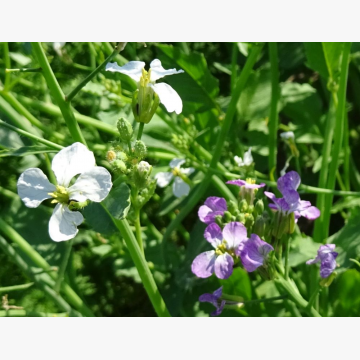- Home
- Seeds
- Catch/Cover crops
- Plants for catch/cover crops
- Fodder radish CANNAVARO (H1)
FOR CONSULTATIONS APPLY TO:
Commercial director
Lina Smalskienė
tel. +370 618 02 551
e-mail linak@agrolitpa.lt
Sales manager
Tautvydas Kliučininkas
tel. +370 681 35 093
e-mail tautvydask@agrolitpa.lt
Sales manager
Eglė Petkevičienė
tel. +370 626 95 458
e-mail eglep@agrolitpa.lt
Sales manager
Kotryna Nakrošytė
tel.: +370 601 39 282
e-mail kotryna@agrolitpa.lt
Fodder radish CANNAVARO (H1)
A late tetraploid fodder radish, 1st class of resistance to beet cyst nematodes
- High biomass
- Tall plants
- Good lodging resistance
- Suitable for nematode control, biofumigation, soil improvement
- Long growing season
- Flowering – late
- Plants – tall
- Produces a lot of green mass
- Root development – medium
- Susceptibility to frost – high
- Production of organic matter – very high
- Very resistant to:
- Beet cyst nematode (BCN) (Heterodera schachtii)
- Ditylenchus dipsaci
- Rhizoctonia
- Less resistant to Meloidogyne hapla (Root-knot nematodes)
- Plant height – 67 (57-76) cm
- Resistant to lodging – 1 point (out of 9, when 9 is totally lodged)
- Vitality – 8.3 points (out of 9)
- Green mass yield potential – 41.71 (40.1-43.32) t/ha
- Dry mass yield potential – 4.18 (3.87-4.49) t/ha
- Amount of dry matter – 12.3 (11.8-12.8) %
- Beet nematodes:
- Attack index - 0.76
- Resistance index 94.62
- Class H1 (strongly reduces the amount of beet nematodes)
*Data from VATE (Agronomic, Technological and Environmental Assessment) studies 2011-2012, GEVES, France
- Suitable for use:
- For nematode control
- For biofumigation
- For erosion control
- For fodder, but the quality of the fodder is medium
- For nitrogen production /trapping in the soil
- For weed suppression
- Not very suitable for use:
- For biogas production
The varietal parameters may differ from those indicated here when the testing circumstances differ from quondam
Recommended sowing rate when growing for seed production: 10-14 kg/ha, interrow spacing – 12-15 cm
Recommended sowing rate when growing for green manure: 25-30 kg/ha
Keravos sreet. 17, Kerava,
LT-38 131 Panevėžys district, LITHUANIA
Enterprise's code 168598128
VAT code LT685981219
Tel. +370 615 11 315
E. mail info@agrolitpa.lt




.JPG)

